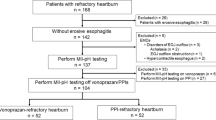Abstract
It has been reported that proton pump inhibitors are more effective than H2 receptor antagonists in patients with functional dyspepsia. Dyspeptic symptoms that respond to proton pump inhibitors are classified as acid-related dyspepsia. A new questionnaire for assessing gastroesophageal reflux disease (GERD), the Frequency Scale for Symptoms of GERD, covers the 12 most common symptoms of GERD patients. A quantitative assessment of the changes of reflux symptoms and acid-related dyspepsia was made in GERD patients receiving proton pump inhibitor therapy. Sixty-eight GERD patients receiving proton pump inhibitor therapy completed the questionnaire before and after treatment for 8 weeks. There is a significant positive correlation between reflux symptoms and acid-related dyspepsia before and after therapy (r = 0.569 and r = 0.569; both P’s < 0.001) and acid-related dyspepsia in patients with both nonerosive and erosive GERD. We conclude that GERD patients suffer not only from reflux symptoms, but also from acid-related dyspepsia, and proton pump inhibitors improve both types of symptoms.




Similar content being viewed by others
References
Kusano M, Shimoyama Y, Sugimoto S, et al. (2004) Development and evaluation of FSSG: frequency scale for the symptoms of GERD. J Gastroenterol 39:888–891
Dupuy HJ (1984) The psychological general well-being (PGWB) index. In: Wenger NK, Mattson ME, Furberg CD, et al. (eds) Assessment of quality of life in clinical trials of cardiovascular therapies. Le Jacq, New York, pp 170–183
Svedlund J, Sjodin I, Dotevall G (1988) GSRS—a clinical rating scale for gastrointestinal symptoms in patients with irritable bowel syndrome and peptic ulcer disease. Dig Dis Sci 33:129–134
Ware JE, Sherbourne CD (1992) The MOS 36-item short form health survey (SF-36). Med Care 30:473–481
Jones RH, Baxter G (1997) Lansoprazole 30 mg daily versus ranitidine 150 mg b.d. in the treatment of acid-related dyspepsia in general practice. Aliment Pharmacol Ther 11:541–546
Quigley EMM (2004) Review article: gastric emptying in functional gastrointestinal disorders. Aliment Pharmacol Ther 20(Suppl 7):56–60
Armstrong D, Bennett JR, Blum AL, et al. (1996) The endoscopic assessment of esophagitis: A progress report on observer agreement. Gastroenterology 111:85–92
Hoshihara Y (1998) Reflux esophagitis. In: Nagasako K, Fujimori T, Hoshihara Y, Tabuchi M (eds) Atlas of gastroenterologic endoscopy by high-resolution video-endoscope. Igaku-Shoin, Tokyo, p 32
Oda K, Iwakiri R, Hara M, et al. (2005) Dysphagia associated with gastroesophageal reflux disease is improved by proton pump inhibitor. Dig Dis Sci 50:1921–1926
Shi G, Bruley dV, Scarpignato C, Le RM, Galmiche JP (1995) Reflux related symptoms in patients with normal oesophageal exposure to acid. Gut 37:457–464
Hobson AR, Khan RW, Sarkar S, Furlong PL, Aziz Q (2004) Development of esophageal hypersensitivity following experimental duodenal acidification. Am J Gastroenterol 99:813–820
Lee KJ, Kim JH, Cho SW (2006) Dyspeptic symptoms associated with hypersensitivity to gastric distension induced by duodenal acidification. J Gastroenterol Hepatol 21:515–520
Tack J, Caenepeel P, Fischler B, Piessevaux H, Janssens J (2001) Symptoms associated with hypersensitivity to gastric distention in functional dyspepsia. Gastroenterology 121:526–535
Herculano JRL, Troncon LE, Aprile LR, et al. (2004) Diminished retention of food in the proximal stomach correlates with increased acidic reflux in patients with gastroesophageal reflux disease and dyspeptic symptoms. Dig Dis Sci 49:750–756
Maddern GJ, Jamieson GG, Myers JC, Collins PJ (1991) Effect of cisapride on delayed gastric emptying in gastro-oesophageal reflux disease. Gut 32:470–474
Berstad A (1998) Today’s therapy of functional gastrointestinal disorders—Does it help? Eur J Surg 583(Suppl):92–97
Lin M, Gerson LB, Lascar R, Davila M, Triadafilopoulos G (2004) Features of gastroesophageal reflux disease in women. Am J Gastroenterol 99:1442–1447
Holtmann G, Talley NJ, Liebregts T, Adam B, Parow C (2006) A placebo-controlled trial of itopride in functional dyspepsia. N Engl J Med 354:832–840
Vigneri S, Termini R, Leandro G, et al. (1995) A comparison of five maintenance therapies for reflux esophagitis. N Engl J Med 333:1106–1110
Author information
Authors and Affiliations
Corresponding author
Rights and permissions
About this article
Cite this article
Kusano, M., Shimoyama, Y., Kawamura, O. et al. Proton Pump Inhibitors Improve Acid-Related Dyspepsia in Gastroesophageal Reflux Disease Patients. Dig Dis Sci 52, 1673–1677 (2007). https://doi.org/10.1007/s10620-006-9674-3
Received:
Accepted:
Published:
Issue Date:
DOI: https://doi.org/10.1007/s10620-006-9674-3




